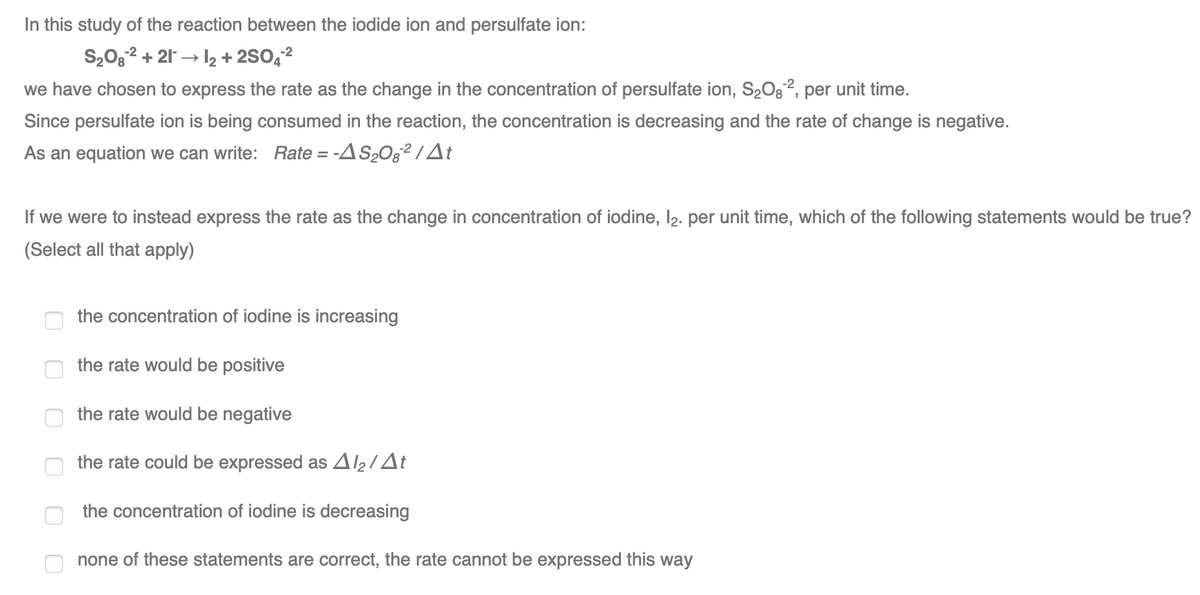In this study of the reaction between the iodide ion and persulfate ion: S20;2 + 21 → I2 + 2SO,² we have chosen to express the rate as the change in the concentration of persulfate ion, S2Og², per unit time. Since persulfate ion is being consumed in the reaction, the concentration is decreasing and the rate of change is negative. As an equation we can write: Rate = -AS2O§² /At If we were to instead express the rate as the change in concentration of iodine, I2. per unit time, which of the following statements would be true (Select all that apply) the concentration of iodine is increasing the rate would be positive the rate would be negative O the rate could be expressed as Al2/At the concentration of iodine is decreasing none of these statements are correct, the rate cannot be expressed this way O O O O O O
In this study of the reaction between the iodide ion and persulfate ion: S20;2 + 21 → I2 + 2SO,² we have chosen to express the rate as the change in the concentration of persulfate ion, S2Og², per unit time. Since persulfate ion is being consumed in the reaction, the concentration is decreasing and the rate of change is negative. As an equation we can write: Rate = -AS2O§² /At If we were to instead express the rate as the change in concentration of iodine, I2. per unit time, which of the following statements would be true (Select all that apply) the concentration of iodine is increasing the rate would be positive the rate would be negative O the rate could be expressed as Al2/At the concentration of iodine is decreasing none of these statements are correct, the rate cannot be expressed this way O O O O O O
Chemistry: The Molecular Science
5th Edition
ISBN:9781285199047
Author:John W. Moore, Conrad L. Stanitski
Publisher:John W. Moore, Conrad L. Stanitski
Chapter11: Chemical Kinetics: Rates Of Reactions
Section11.7: Reaction Mechanisms
Problem 11.12E
Related questions
Question

Transcribed Image Text:In this study of the reaction between the iodide ion and persulfate ion:
S2032 + 21 → 2 + 2SO42
we have chosen to express the rate as the change in the concentration of persulfate ion, S2Og2, per unit time.
Since persulfate ion is being consumed in the reaction, the concentration is decreasing and the rate of change is negative.
As an equation we can write: Rate = -AS2O§² / t
If we were to instead express the rate as the change in concentration of iodine, l2. per unit time, which of the following statements would be true?
(Select all that apply)
the concentration of iodine is increasing
the rate would be positive
the rate would be negative
the rate could be expressed as A2/At
the concentration of iodine is decreasing
none of these statements are correct, the rate cannot be expressed this way
Expert Solution
This question has been solved!
Explore an expertly crafted, step-by-step solution for a thorough understanding of key concepts.
This is a popular solution!
Trending now
This is a popular solution!
Step by step
Solved in 3 steps

Knowledge Booster
Learn more about
Need a deep-dive on the concept behind this application? Look no further. Learn more about this topic, chemistry and related others by exploring similar questions and additional content below.Recommended textbooks for you

Chemistry: The Molecular Science
Chemistry
ISBN:
9781285199047
Author:
John W. Moore, Conrad L. Stanitski
Publisher:
Cengage Learning

Chemistry: Principles and Practice
Chemistry
ISBN:
9780534420123
Author:
Daniel L. Reger, Scott R. Goode, David W. Ball, Edward Mercer
Publisher:
Cengage Learning

General Chemistry - Standalone book (MindTap Cour…
Chemistry
ISBN:
9781305580343
Author:
Steven D. Gammon, Ebbing, Darrell Ebbing, Steven D., Darrell; Gammon, Darrell Ebbing; Steven D. Gammon, Darrell D.; Gammon, Ebbing; Steven D. Gammon; Darrell
Publisher:
Cengage Learning

Chemistry: The Molecular Science
Chemistry
ISBN:
9781285199047
Author:
John W. Moore, Conrad L. Stanitski
Publisher:
Cengage Learning

Chemistry: Principles and Practice
Chemistry
ISBN:
9780534420123
Author:
Daniel L. Reger, Scott R. Goode, David W. Ball, Edward Mercer
Publisher:
Cengage Learning

General Chemistry - Standalone book (MindTap Cour…
Chemistry
ISBN:
9781305580343
Author:
Steven D. Gammon, Ebbing, Darrell Ebbing, Steven D., Darrell; Gammon, Darrell Ebbing; Steven D. Gammon, Darrell D.; Gammon, Ebbing; Steven D. Gammon; Darrell
Publisher:
Cengage Learning

Chemistry for Engineering Students
Chemistry
ISBN:
9781285199023
Author:
Lawrence S. Brown, Tom Holme
Publisher:
Cengage Learning

Chemistry by OpenStax (2015-05-04)
Chemistry
ISBN:
9781938168390
Author:
Klaus Theopold, Richard H Langley, Paul Flowers, William R. Robinson, Mark Blaser
Publisher:
OpenStax

Chemistry & Chemical Reactivity
Chemistry
ISBN:
9781337399074
Author:
John C. Kotz, Paul M. Treichel, John Townsend, David Treichel
Publisher:
Cengage Learning